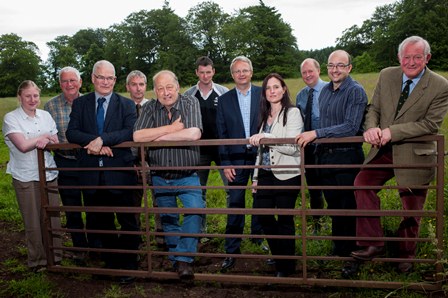



Johne's Control Needs a Long Term Strategy, but Achieves Results
A three year study into the control of Johne’s, a major wasting disease of cattle, shows it is possible to significantly reduce on-farm infection, but often requires a long term strategic approach to disease control and the commitment of both farmer and vet.
During the project researchers took 13,000 blood samples, analysed soil and abattoir material and studied farm management systems to discover their role in disease spread. The findings of the PARABAN project, which involved 9 volunteer livestock farms experiencing Johne’s Disease problems, were explained during a final on-farm meeting at Glenbervie, Aberdeenshire.

“In the three years the number of blood tests showing positive for Johne’s infection dropped by 65%”, said Inverness based Dr Selene Huntley, from Scotland’s Rural College, which led the PARABAN programme. “That is real progress, but no one should believe there is a simple, single solution to tackling this disease. Control frequently requires long term thinking, strategic planning and the determination to carry it through.”
PARABAN was funded by the Scottish Funding Council, in partnership with Scottish Government and industry. Working with SRUC were specialists from the Universities of Glasgow, Edinburgh and the James Hutton Institute. Industry contributions, some of it in kind, were co ordinated by Quality Meat Scotland (QMS). The partners worked with volunteer beef or dairy farmers and their vets, from across Scotland and into Cumbria.
All the herds had suffered problems with Johne’s (pron Yoanays ) which is caused by Mycobacterium avium ssp, paratuberculosis. Cattle with it develop a thickening of the small intestine and, while apparently eating normally have severe diarrhoea, loose weight and become very thin. Calves become infected by ingesting bacteria from surfaces contaminated with infected dung, but the disease has a long incubation period so it is usually several years before the disease takes hold.
According to Selene Huntley the key to tackling the problem is first knowing the level of infection and then actively managing the risk:
“Not every infected animal shows symptoms and these sub clinical cases can be important spreaders of disease. In the programme we blood tested the herds twice a year, but even one annual test is vitally important.”
Once identified, animals testing positive for infection were dealt with according to each farmers’ action plan for reducing the risk of passing on infection at the key calving period. Successful strategies for beef herds included testing and culling, testing with a delayed cull after calving or weaning, testing and separately managing positive cows (eg not retaining highest risk progeny for breeding). With dairy cows, removing calves at birth from positive mothers, not feeding colostrum or milk to calves from positive mothers and feeding pasteurised colostrum or milk replacement to calves.
Nearly all the farms in the project showed significant reductions in the incidence of Johne’s, although recently, on two units there has been an unexplained spike in the number of positive tests:
“We are investigating it,” says Dr Huntley. ”But it is not uncommon and emphasises the need for farmers to understand this is a long term strategy based on advice, knowledge and understanding. It’s important not to lose confidence in what you are doing.”
Other aspects of the research included studies of environmental conditions and a range of abattoir tests. These helped build a picture of the disease and inform any control strategy. For example an understanding of soil pH, available iron and organic matter can help explain why certain fields seem to harbour the disease more than others. Abattoir testing is a potential means of screening for infection at the herd level but may be impractical.
According to Selene Huntley:
“What is very clear is the need for farmers to gain as much knowledge as they can about Johnes and potential control measures. We have held a series of roadshow events throughout the programme and 45% of those farmers who attended declared they would change their approach to Johne’s. Reducing infection in the national herd will depend on farmer awareness. We hope the Glebervie meeting has been another step in that direction.”
Click here to view the PARABAN Project video.
Photo L-R: Mary Flook, University of Glasgow; Ian Milne, farmer; Professor George Gunn, Scotland’s Rural College (SRUC); Bill Robson, vet; John Lahoar, farm manager; Sandy Milne, farmer; Alastair Macphie, Macphie of Glenbervie Ltd; Dr Selene Huntley, Scotland’s Rural College (SRUC); Nigel Miller, NFU Scotland; Dr Rupert Hough, The James Hutton Institute; and Mike Gibson, PARABAN project chairman.


